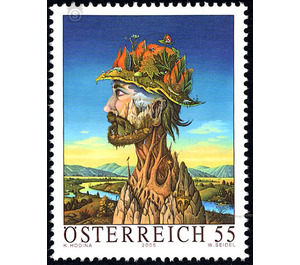Modern Art - Austria / II. Republic of Austria 2005 - 55 Euro Cent
Theme: Art & Culture
| Country | Austria / II. Republic of Austria |
| Issue Date | 2005 |
| Face Value | 55.00 |
| Edition Issued | 700,000 |
| Printing Type | combination printing |
| Stamp Type | Commemorative |
| Item Type | Stamp |
| Chronological Issue Number | 1892 |
| Chronological Chapter | OOS-OE2 |
| SID | 406357 |
| In 55 Wishlists | |
Image: "Waldmeister" A Viennese original - everyone knows him as a musician and interpreter of the new Wienerlied. Born in Vienna in 1935, Karl Hodina began his professional career as a lithographer after the war. He also studied music privately and became enthusiastic about jazz. From 1955 he began training at the Graphische Lehr- and Versuchsanstalt in Vienna. In 1966 he asked about "St. Stephan "in the gallery Basilisk from, he showed his first solo exhibition in 1967 in the GALLERY 6 in the Bäckerstrasse. Many other presentations followed in the form of art calendars or art folders. He illustrated children's books, sat down critically with the Wienerlied, composed and wrote the Wienerliederbuch "O du lieber Augustin" in 1979, performed in concerts and on the ORF, designed the highway rest stop Arnwiesen near Gleisdorf, Stmk. and worked in various cultural associations. In 1984, he was awarded the title Professor for his rich work and cultural commitment. In 2003 he received the Austrian Cross of Honor for Art and Science 1st Class. He inherited his musical talent from his mother's Slovak grandfather. Still on the deathbed, it is said, he played and sang on the accordion. He got the talent for brush and paint from his Bohemian grandfather, who filled in every spare time with his painting as well as his tailoring. In his childhood, Hodina experienced pure nature at Mühlwasser in the Lobau, where the family spent the summer in the allotment garden. His father, who died early of tuberculosis, often took him to fish. The discovery journey through the flora and fauna in this archaic landscape shaped the child. The first images are dominated by motifs from the Lobau, which do not let him go all his life: watermen, fish, ferns, torn nets - Idyllic and fairytale with the aura of pure, untouched. As a teenager, he got close to the poor conditions felt, he grew up in Ottakring in a room-kitchen apartment. From the experience of this time, which also includes the encounter with the Viennese song, his honest feeling arises when he describes the simple conditions, sings, presents. Although Hodina's painterly work is classified under the term "Viennese School of Fantastic Realism", he found his role models in the old masters, such as the brothers van Eyck, and their painting technique, in which water-soluble paints (tempera) were removed with the aid of a binding agent (Ei ) can be set to oil paint without being repelled by them. This technique of the colors applied in several layers of glaze - for Hodina the queen in painting - he has self-taught in decades of painting himself. Essential for him is that all objects of a picture are covered with the same lighting mood, while this glaze painting supports him, a time-consuming technique, a technique for masters.


